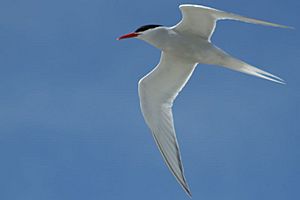South American tern facts for kids
Quick facts for kids South American tern |
|
|---|---|
 |
|
| Conservation status | |
| Scientific classification | |
| Genus: |
Sterna
|
| Species: |
hirundinacea
|
The South American tern (Sterna hirundinacea) is a type of tern, which is a seabird. You can find this bird along the coasts of southern South America. Its home includes the Falkland Islands. It also lives north to Peru on the Pacific coast and Brazil on the Atlantic coast. This tern is usually the most common tern in these areas. It looks a lot like the smaller common tern, which travels long distances. The name "hirundinacea" means "swallow-like." This refers to its forked tail feathers, which look like a swallow's tail.
Contents
What the South American Tern Looks Like
Adult South American terns are about 40 to 44 centimeters (16 to 17 inches) long. This makes them bigger than both common terns and Arctic terns. However, they look very similar to these other terns in their feathers all year round.
The South American tern has a larger beak, which is red when they are adults. They do not have a dark bar on the bend of their wing. Their black cap goes below their eye. A small white crescent usually separates the cap from the eye. The back edge of the cap is very neat and clear.
Young South American terns have dark, striped patterns on their upper bodies. They keep these striped feathers on their wings as they grow older. This helps tell them apart from young common and Arctic terns.
Where the South American Tern Lives
This tern lives along the coasts of the southern part of South America. For breeding, it can be found on the Atlantic coast from central Brazil southwards. This includes Argentina and the Falkland Islands, all the way to Tierra del Fuego. On the Pacific coast, it breeds in southern Peru and Chile.
When winter comes, birds from the very south travel north. They fly to places like Ecuador, Uruguay, and southern Brazil.
How the South American Tern Behaves
The South American tern eats different kinds of food. It hunts for fish, small crabs, and other tiny sea creatures.
These birds build their nests on islands, sandy beaches, and the tops of cliffs. When they are not breeding, you might see them out at sea. They also visit estuaries (where rivers meet the sea) and harbors.
In 1877, people found a large group of these terns nesting on a beach in Chubut Province, Argentina. Many birds were nesting in an area about 125 square meters (150 square yards). Their nests were simple scrapes in the gravel and small stones. Each nest usually held one, two, or three eggs. The eggs were smaller than those of the Sandwich tern. They looked similar, but each egg had different markings. It was hard to walk without stepping on an egg because there were so many nests. People estimated there could have been over 100,000 eggs in that one colony!
See also
 In Spanish: Charrán sudamericano para niños
In Spanish: Charrán sudamericano para niños



